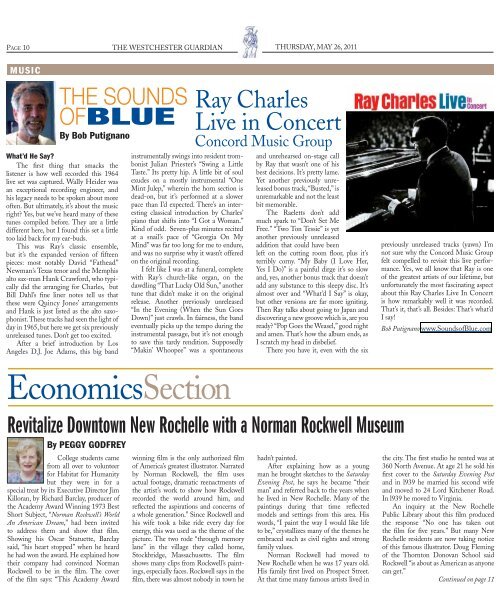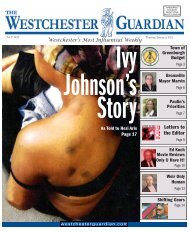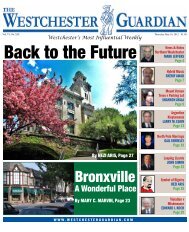Westchester County Executive Rob Astorino Fooled Us ... - Typepad
Westchester County Executive Rob Astorino Fooled Us ... - Typepad
Westchester County Executive Rob Astorino Fooled Us ... - Typepad
You also want an ePaper? Increase the reach of your titles
YUMPU automatically turns print PDFs into web optimized ePapers that Google loves.
PAGE 10 THE WESTCHESTER GUARDIAN THURSDAY, MAY 26, 2011<br />
MUSIC<br />
<br />
<br />
By Bob Putignano<br />
What’d He Say?<br />
The first thing that smacks the<br />
listener is how well recorded this 1964<br />
live set was captured. Wally Heider was<br />
an exceptional recording engineer, and<br />
his legacy needs to be spoken about more<br />
often. But ultimately, it’s about the music<br />
right? Yes, but we’ve heard many of these<br />
tunes compiled before. They are a little<br />
different here, but I found this set a little<br />
too laid back for my ear-buds.<br />
This was Ray’s classic ensemble,<br />
but it’s the expanded version of fifteen<br />
pieces: most notably David “Fathead”<br />
Newman’s Texas tenor and the Memphis<br />
alto sax-man Hank Crawford, who typically<br />
did the arranging for Charles, but<br />
Bill Dahl’s fine liner notes tell us that<br />
these were Quincy Jones’ arrangements<br />
and Hank is just listed as the alto saxophonist.<br />
These tracks had seen the light of<br />
day in 1965, but here we get six previously<br />
unreleased tunes. Don’t get too excited.<br />
After a brief introduction by Los<br />
Angeles D.J. Joe Adams, this big band<br />
instrumentally swings into resident trombonist<br />
Julian Priester’s “Swing a Little<br />
Taste.” Its pretty hip. A little bit of soul<br />
exudes on a mostly instrumental “One<br />
Mint Julep,” wherein the horn section is<br />
dead-on, but it’s performed at a slower<br />
pace than I’d expected. There’s an interesting<br />
classical introduction by Charles’<br />
piano that shifts into “I Got a Woman.”<br />
Kind of odd. Seven-plus minutes recited<br />
at a snail’s pace of “Georgia On My<br />
Mind” was far too long for me to endure,<br />
and was no surprise why it wasn’t offered<br />
on the original recording.<br />
I felt like I was at a funeral, complete<br />
with Ray’s church-like organ, on the<br />
dawdling “That Lucky Old Sun,” another<br />
tune that didn’t make it on the original<br />
release. Another previously unreleased<br />
“In the Evening (When the Sun Goes<br />
Down)” just crawls. In fairness, the band<br />
eventually picks up the tempo during the<br />
instrumental passage, but it’s not enough<br />
to save this tardy rendition. Supposedly<br />
“Makin’ Whoopee” was a spontaneous<br />
Ray Charles<br />
Live in Concert<br />
Concord Music Group<br />
and unrehearsed on-stage call<br />
by Ray that wasn’t one of his<br />
best decisions. It’s pretty lame.<br />
Yet another previously unreleased<br />
bonus track, “Busted,” is<br />
unremarkable and not the least<br />
bit memorable.<br />
The Raeletts don’t add<br />
much spark to “Don’t Set Me<br />
Free.” “Two Ton Tessie” is yet<br />
another previously unreleased<br />
addition that could have been<br />
left on the cutting room floor, plus it’s<br />
terribly corny. “My Baby (I Love Her,<br />
Yes I Do)” is a painful dirge it’s so slow<br />
and, yes, another bonus track that doesn’t<br />
add any substance to this sleepy disc. It’s<br />
almost over and “What’d I Say” is okay,<br />
but other versions are far more igniting.<br />
Then Ray talks about going to Japan and<br />
discovering a new groove which is, are you<br />
ready? “Pop Goes the Weasel,” good night<br />
and amen. That’s how the album ends, as<br />
I scratch my head in disbelief.<br />
There you have it, even with the six<br />
previously unreleased tracks (yawn) I’m<br />
not sure why the Concord Music Group<br />
felt compelled to revisit this live performance.<br />
Yes, we all know that Ray is one<br />
of the greatest artists of our lifetime, but<br />
unfortunately the most fascinating aspect<br />
about this Ray Charles Live In Concert<br />
is how remarkably well it was recorded.<br />
That’s it, that’s all. Besides: That’s what’d<br />
I say!<br />
Bob Putignano www.SoundsofBlue.com<br />
EconomicsSection<br />
Revitalize Downtown New Rochelle with a Norman Rockwell Museum<br />
By PEGGY GODFREY<br />
College students came<br />
from all over to volunteer<br />
for Habitat for Humanity<br />
but they were in for a<br />
special treat by its <strong>Executive</strong> Director Jim<br />
Killoran, by Richard Barclay, producer of<br />
the Academy Award Winning 1973 Best<br />
Short Subject, “Norman Rockwell’s World<br />
An American Dream,” had been invited<br />
to address them and show that film.<br />
Showing his Oscar Statuette, Barclay<br />
said, “his heart stopped” when he heard<br />
he had won the award. He explained how<br />
their company had convinced Norman<br />
Rockwell to be in the film. The cover<br />
of the film says: “This Academy Award<br />
winning film is the only authorized film<br />
of America’s greatest illustrator. Narrated<br />
by Norman Rockwell, the film uses<br />
actual footage, dramatic reenactments of<br />
the artist’s work to show how Rockwell<br />
recorded the world around him, and<br />
reflected the aspirations and concerns of<br />
a whole generation.” Since Rockwell and<br />
his wife took a bike ride every day for<br />
energy, this was used as the theme of the<br />
picture. The two rode “through memory<br />
lane” in the village they called home,<br />
Stockbridge, Massachusetts. The film<br />
shows many clips from Rockwell’s paintings,<br />
especially faces. Rockwell says in the<br />
film, there was almost nobody in town he<br />
hadn’t painted.<br />
After explaining how as a young<br />
man he brought sketches to the Saturday<br />
Evening Post, he says he became “their<br />
man” and referred back to the years when<br />
he lived in New Rochelle. Many of the<br />
paintings during that time reflected<br />
models and settings from this area. His<br />
words, “I paint the way I would like life<br />
to be,” crystallizes many of the themes he<br />
embraced such as civil rights and strong<br />
family values.<br />
Norman Rockwell had moved to<br />
New Rochelle when he was 17 years old.<br />
His family first lived on Prospect Street.<br />
At that time many famous artists lived in<br />
the city. The first studio he rented was at<br />
360 North Avenue. At age 21 he sold his<br />
first cover to the Saturday Evening Post<br />
and in l939 he married his second wife<br />
and moved to 24 Lord Kitchener Road.<br />
In l939 he moved to Virginia.<br />
An inquiry at the New Rochelle<br />
Public Library about this film produced<br />
the response “No one has taken out<br />
the film for five years.” But many New<br />
Rochelle residents are now taking notice<br />
of this famous illustrator. Doug Fleming<br />
of the Thornton Donovan School said<br />
Rockwell “is about as American as anyone<br />
can get.”<br />
Continued on page 11














